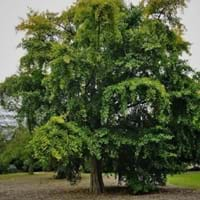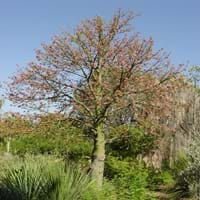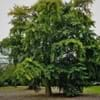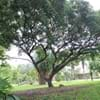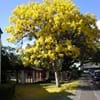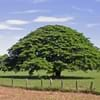Life Span
Perennial
Perennial
Types
Not Available
Not Available
Habitat
Deciduous forests, Wild, Woods
Canopy, Rainforest
USDA Hardiness Zone
4-9
9-13
Sunset Zone
A3, 1a, 1b, 2a, 2b, 3a, 3b, 4, 5, 6, 7, 8, 9, 10, 12, 14, 15, 16, 17, 18, 19, 20, 21, 22, 23, 24
H1, H2, 15, 16, 17, 18, 19, 20, 21, 22, 23, 24
Habit
Upright/Erect
Spreading
Flower Color
Yellow green
Rose
Flower Color Modifier
Bicolor
Bicolor
Fruit Color
Orange, Light Yellow, Tan
Gold, Brown
Leaf Color in Spring
Light Green, Yellow green
Not Available
Leaf Color in Summer
Green, Yellow green
Green, Blue Green
Leaf Color in Fall
Yellow, Gold
Green, Blue Green
Leaf Color in Winter
Not Available
Green, Blue Green
Leaf Shape
Bi-lobed
Lobulated
Plant Season
Spring, Summer, Fall, Winter
Spring, Summer, Fall
Sunlight
Full Sun
Full Sun, Partial Sun
Type of Soil
Clay, Loam, Sand
Clay, Loam, Sand
The pH of Soil
Acidic, Neutral
Acidic, Neutral
Soil Drainage
Well drained
Average
Bloom Time
Spring
Late Spring, Early Summer, Summer
Tolerances
Pollution, Drought, Salt, Soil Compaction
Wet Site, Drought, Soil Compaction
Where to Plant?
Ground
Ground
How to Plant?
Seedlings, Spores, Stem Planting
Seedlings
Plant Maintenance
Medium
Medium
Watering Requirements
Requires watering in the growing season
Do not let dry out between waterings, Requires consistently moist soil
In Summer
Lots of watering
Lots of watering
In Spring
Moderate
Moderate
In Winter
Average Water
Average Water
Soil pH
Acidic, Neutral
Acidic, Neutral
Soil Type
Clay, Loam, Sand
Clay, Loam, Sand
Soil Drainage Capacity
Well drained
Average
Sun Exposure
Full Sun
Full Sun, Partial Sun
Pruning
Remove damaged leaves, Remove dead branches, Remove dead leaves
Remove damaged leaves, Remove dead branches, Remove dead leaves
Fertilizers
All-Purpose Liquid Fertilizer
All-Purpose Liquid Fertilizer
Pests and Diseases
Red blotch
Root rot
Plant Tolerance
Drought
Drought
Flowers
Insignificant
Showy
Flower Petal Number
Single
Single
Foliage Texture
Medium
Medium
Foliage Sheen
Matte
Matte
Attracts
Birds, Butterflies, Squirrels
Hummingbirds
Allergy
Abdominal pain, Nausea, Throat itching, Vomiting
Not Available
Aesthetic Uses
Bonsai
Showy Purposes
Beauty Benefits
Acne, For treating wrinkles, Remove blemishes
Not Available
Environmental Uses
Air purification, Nesting sites for birds, Shadow Tree, soil erosion prevension on hill slopes
Air purification
Medicinal Uses
Aging, Alzheimer’s Disease, anti-allergy, anti-inflammatory, Blood anti-coagulant, Diabetes
No Medicinal Use
Part of Plant Used
Bark, Leaves, Seeds
Seeds, Wood
Other Uses
Can be made into a herbal tea, Condiment, Cosmetics, Medicinal oil
Edible seed, Used as Ornamental plant, Used to make wood shingles
Used As Indoor Plant
Sometimes
No
Used As Outdoor Plant
Yes
Yes
Garden Design
Feature Plant, Shade Trees, Street Trees
Feature Plant, Shade Trees, Street Trees, Tropical
Botanical Name
GINKGO biloba 'Chi-chi'
BRACHYCHITON discolor
Common Name
Ginkgo
Bush Kurrajong, Pink Flame Tree, Queensland Lacebark
In Hindi
बालकुवारी
Pink Flame Tree
In German
Tempelbaum, Ginkgobaum
Rosa Flame Tree
In French
Arbre sacré des temples d'Asie, Arbre aux mille écus
Flame Tree Rose
In Spanish
Gingo, Árbol de oro
Pink árbol de la llama
In Greek
Γιγκο, Γκίνγκο
Ροζ Φλόγα Δέντρο
In Portuguese
Nogueira-do-Japão
Árvore Chama Rosa
In Polish
Miłorząb chiński, Miłorząb dwudzielny
Różowy Flame Tree
In Latin
Gingko
Pink arbor flamma
Phylum
Ginkgophyta
Magnoliophyta
Class
Ginkgoopsida
Magnoliopsida
Order
Ginkgoales
Malvales
Family
Ginkgoaceae
Sterculiaceae
Genus
Ginkgo
brachychiton
Clade
Cycad
Angiosperms, Eudicots, Rosids
Tribe
Not Available
Sterculieae
Subfamily
Not Available
Sterculioideae
Number of Species
Not Available
Not Available
Season and Care of Ginkgo and Pink Flame Tree
Season and care of Ginkgo and Pink Flame Tree is important to know. While considering everything about Ginkgo and Pink Flame Tree Care, growing season is an essential factor. Ginkgo season is Spring, Summer, Fall and Winter and Pink Flame Tree season is Spring, Summer, Fall and Winter. The type of soil for Ginkgo is Clay, Loam, Sand and for Pink Flame Tree is Clay, Loam, Sand while the PH of soil for Ginkgo is Acidic, Neutral and for Pink Flame Tree is Acidic, Neutral.
Ginkgo and Pink Flame Tree Physical Information
Ginkgo and Pink Flame Tree physical information is very important for comparison. Ginkgo height is 460.00 cm and width 240.00 cm whereas Pink Flame Tree height is 1,220.00 cm and width 610.00 cm. The color specification of Ginkgo and Pink Flame Tree are as follows:
Ginkgo flower color: Yellow green
Ginkgo leaf color: Light Green and Yellow green
Pink Flame Tree flower color: Rose
- Pink Flame Tree leaf color: Not Available
Care of Ginkgo and Pink Flame Tree
Care of Ginkgo and Pink Flame Tree include pruning, fertilizers, watering etc. Ginkgo pruning is done Remove damaged leaves, Remove dead branches and Remove dead leaves and Pink Flame Tree pruning is done Remove damaged leaves, Remove dead branches and Remove dead leaves. In summer Ginkgo needs Lots of watering and in winter, it needs Average Water. Whereas, in summer Pink Flame Tree needs Lots of watering and in winter, it needs Average Water.
